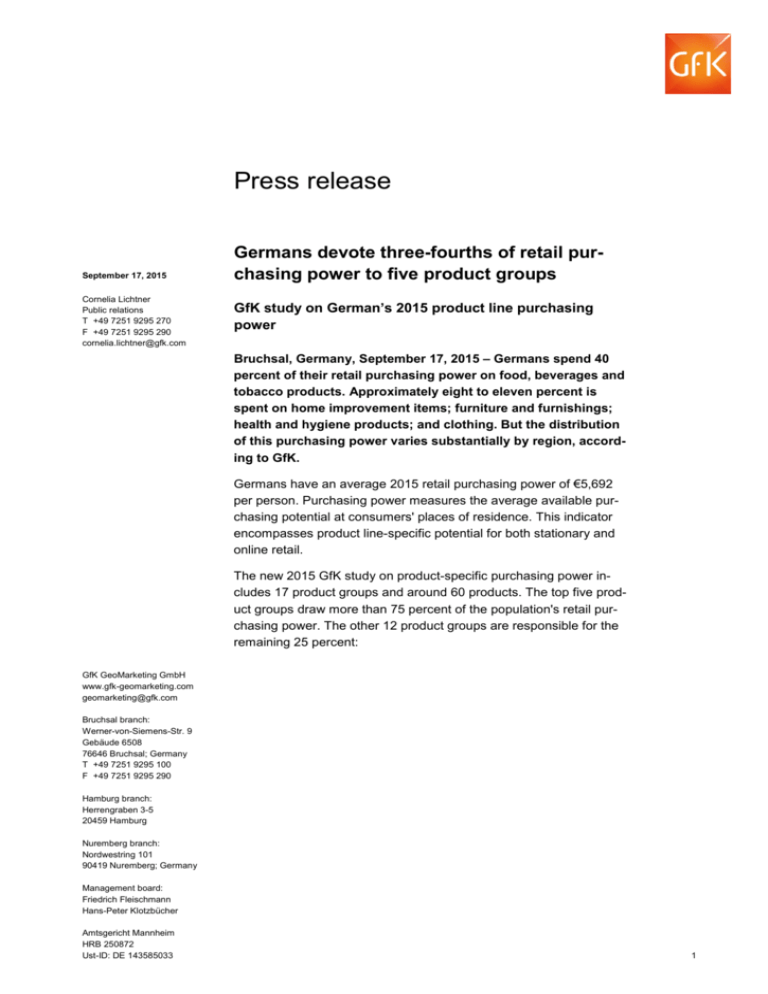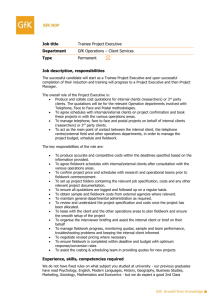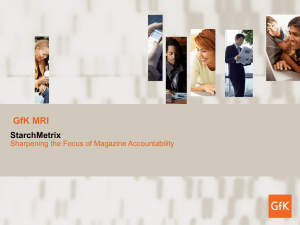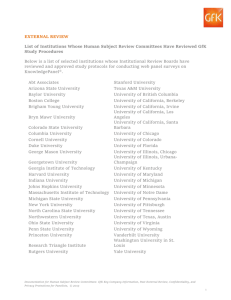Germans devote three-fourths of retail purchasing power to five
advertisement

Press release September 17, 2015 Cornelia Lichtner Public relations T +49 7251 9295 270 F +49 7251 9295 290 cornelia.lichtner@gfk.com Germans devote three-fourths of retail purchasing power to five product groups GfK study on German’s 2015 product line purchasing power Bruchsal, Germany, September 17, 2015 – Germans spend 40 percent of their retail purchasing power on food, beverages and tobacco products. Approximately eight to eleven percent is spent on home improvement items; furniture and furnishings; health and hygiene products; and clothing. But the distribution of this purchasing power varies substantially by region, according to GfK. Germans have an average 2015 retail purchasing power of €5,692 per person. Purchasing power measures the average available purchasing potential at consumers' places of residence. This indicator encompasses product line-specific potential for both stationary and online retail. The new 2015 GfK study on product-specific purchasing power includes 17 product groups and around 60 products. The top five product groups draw more than 75 percent of the population's retail purchasing power. The other 12 product groups are responsible for the remaining 25 percent: GfK GeoMarketing GmbH www.gfk-geomarketing.com geomarketing@gfk.com Bruchsal branch: Werner-von-Siemens-Str. 9 Gebäude 6508 76646 Bruchsal; Germany T +49 7251 9295 100 F +49 7251 9295 290 Hamburg branch: Herrengraben 3-5 20459 Hamburg Nuremberg branch: Nordwestring 101 90419 Nuremberg; Germany Management board: Friedrich Fleischmann Hans-Peter Klotzbücher Amtsgericht Mannheim HRB 250872 Ust-ID: DE 143585033 1 product line 2015 product-line purchasing power per inhabitant in € share as a % 2,324 40.8 home improvement items 623 10.9 furniture and furnishings 458 8.0 health and hygiene products 452 7.9 clothing 446 7.8 books, stationery 241 4.2 188 3.3 180 3.2 information technology 116 2.0 toys, hobbies 113 2.0 photo, optics 113 2.0 shoes, leather goods 110 1.9 sporting goods, camping 108 1.9 household products 83 1.5 watches, jewelry 74 1.3 telecommunications 46 0.8 infant and children's items 16 0.3 food electrical household appliances consumer electronics, electronic media 75.6% source: GfK Purchasing Power for Retail Product Lines, Germany 2015 The GfK study shows that even purchasing power for basic needs such as eating, drinking, health, clothing and housing is not evenly distributed across the country. Regional potential for home improvement products With an average purchasing power potential of €623 per person, home improvement items occupy a special place in German retail. Almost eleven percent of Germans' retail purchasing power is spent on typical home improvement items such as garden products, automobile accessories and pet supplies. The nation's leader in this regard is the rural district of Starnberg in Bavaria, whose inhabitants have a per-capita purchasing power of €813 for home improvement items. At the other end of the rankings is the urban district of Gelsenkirchen in North Rhine-Westphalia, whose inhabitants have just €436 per person for this product group. The 2 range extends from 30 percent above the national average in Starnberg to 30 percent below in Gelsenkirchen. Inhabitants of the rural district of Lörrach in Baden-Wuerttemberg occupy the middle of the spectrum. Hesse embraces meat and wine The purchasing power data reveals some peculiarities in consumers' preferences across Germany's various federal states. Hesse has the nation's highest purchasing power for meat: At €157 per person, inhabitants of Hesse have around six percent more purchasing power for this product than the national average. Despite the famous “Frankfurter” sausages from Hesse, this federal state has a purchasing power for sausage that is only around 2.4 percent higher than the national average. Inhabitants of Bavaria are far more enthusiastic sausage eaters, with 11.2 percent more purchasing power for this product line than the rest of the country. But Hesse is the undisputable leader in wine-related purchasing power. With €115 per person, inhabitants of Hesse have 25 percent more purchasing power for wine than the average German. About the study The study "GfK Purchasing Power for Retail Product Lines 2015" is calculated on the basis of various surveys and analyses of retailrelated consumer behavior. The study also takes into account data from the GfK consumer panel, which anonymizes the expenditures of a representative sample of approximately 30,000 German households. On the basis of this consumer information, GfK's Geomarketing solution area uses socio-demographic comparisons and geostatistical modeling to calculate regional, product-specific purchasing power for around 60 products. GfK can also calculate retailer-specific regional sales potential for more than 200 product groups. GfK's data provides comprehensive coverage of all of Germany's administrative and postal levels, from the country's federal states and municipalities to five-digit postcodes and street segments. GfK also offers product line-specific purchasing power for other European countries. Purchasing power is provided in the form of forecasted nominal values, meaning that they have not been adjusted for inflation. These values are based on consumers' places of residence rather than on points of sale. The data comprises average values for all inhabitants of a given region. These figures therefore cannot be used to draw conclusions regarding the financial wealth of individuals. 3 Additional information on GfK's regional market data can be found at www.gfk.com/marketdata. Print-quality illustrations can be found at http://www.gfk.com/Documents/PressReleases/2015/product-lines.zip About GfK GfK is the trusted source of relevant market and consumer information that enables its clients to make smarter decisions. More than 13,000 market research experts combine their passion with GfK’s long-standing data science experience. This allows GfK to deliver vital global insights matched with local market intelligence from more than 100 countries. By using innovative technologies and data sciences, GfK turns big data into smart data, enabling its clients to improve their competitive edge and enrich consumers' experiences and choices. Additional information can be found at www.gfk.com. Follow us on Twitter: www.twitter.com/gfk. Responsible under press legislation / V.i.S.d.P. GfK GeoMarketing GmbH Public Relations Cornelia Lichtner Werner-von-Siemens-Str. 9 Gebäude 6508 76646 Bruchsal; Germany T+49 7251 9295 270 cornelia.lichtner@gfk.com 4






